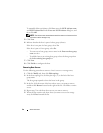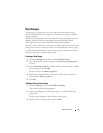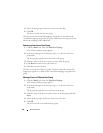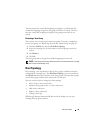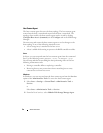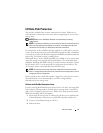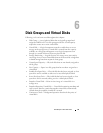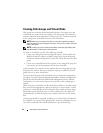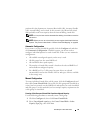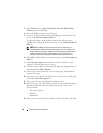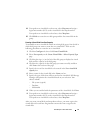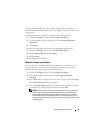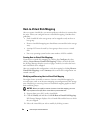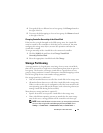
54 Disk Groups and Virtual Disks
Creating Disk Groups and Virtual Disks
Disk groups are created in the unconfigured capacity of a storage array, and
virtual disks are created in the free capacity of a disk group. The maximum
number of physical disks supported in a disk group is 30. The hosts attached
to the storage array read and write data to the virtual disks.
NOTE: Before you can create virtual disks, you must first organize the physical
disks into disk groups and configure host access. Then you can create virtual disks
within a disk group.
NOTE: The disk group must contain physical disks of the same type. Mixing SAS
and SATA II disks in a disk group is not supported.
To create a virtual disk, use one of the following methods:
• Create a new disk group from unconfigured capacity. You first define the
RAID level and free capacity (available storage space) for the disk group,
and then you define the parameters for the first virtual disk in the new disk
group.
• Create a new virtual disk in the free capacity of an existing disk group. You
only need to specify the parameters for the new virtual disk.
A disk group has a set amount of free capacity that was configured when the
disk group was created. You can use that free capacity to subdivide the disk
group into one or more virtual disks.
You can create disk groups and virtual disks using an automatic configuration
procedure or using a manual configuration procedure. Automatic configuration
provides the fastest method, but with limited configuration options. Manual
configuration is a more involved process, but provides more configuration
options.
When creating a virtual disk, consider all of the possible uses for that virtual
disk, and select an appropriate capacity for those uses. For example, if a disk
group has a virtual disk that stores multimedia files (which tend to be large)
and another virtual disk that stores text files (which tend to be small), the
multimedia file virtual disk requires more capacity than the text file virtual
disk.
A disk group should be organized according to its related tasks and subtasks.
For example, if you create a disk group for the Accounting Department, you
can create virtual disks that match the different types of accounting



